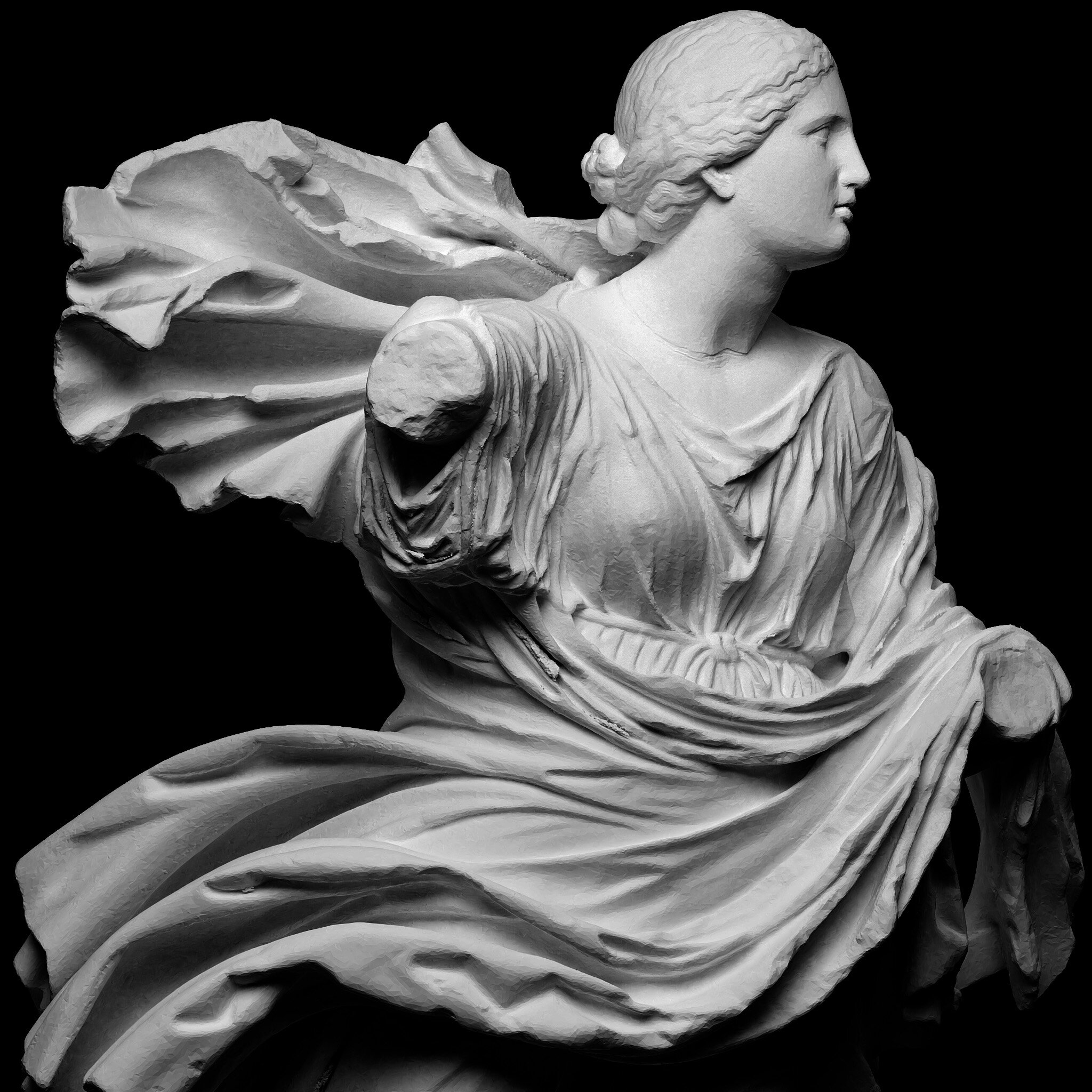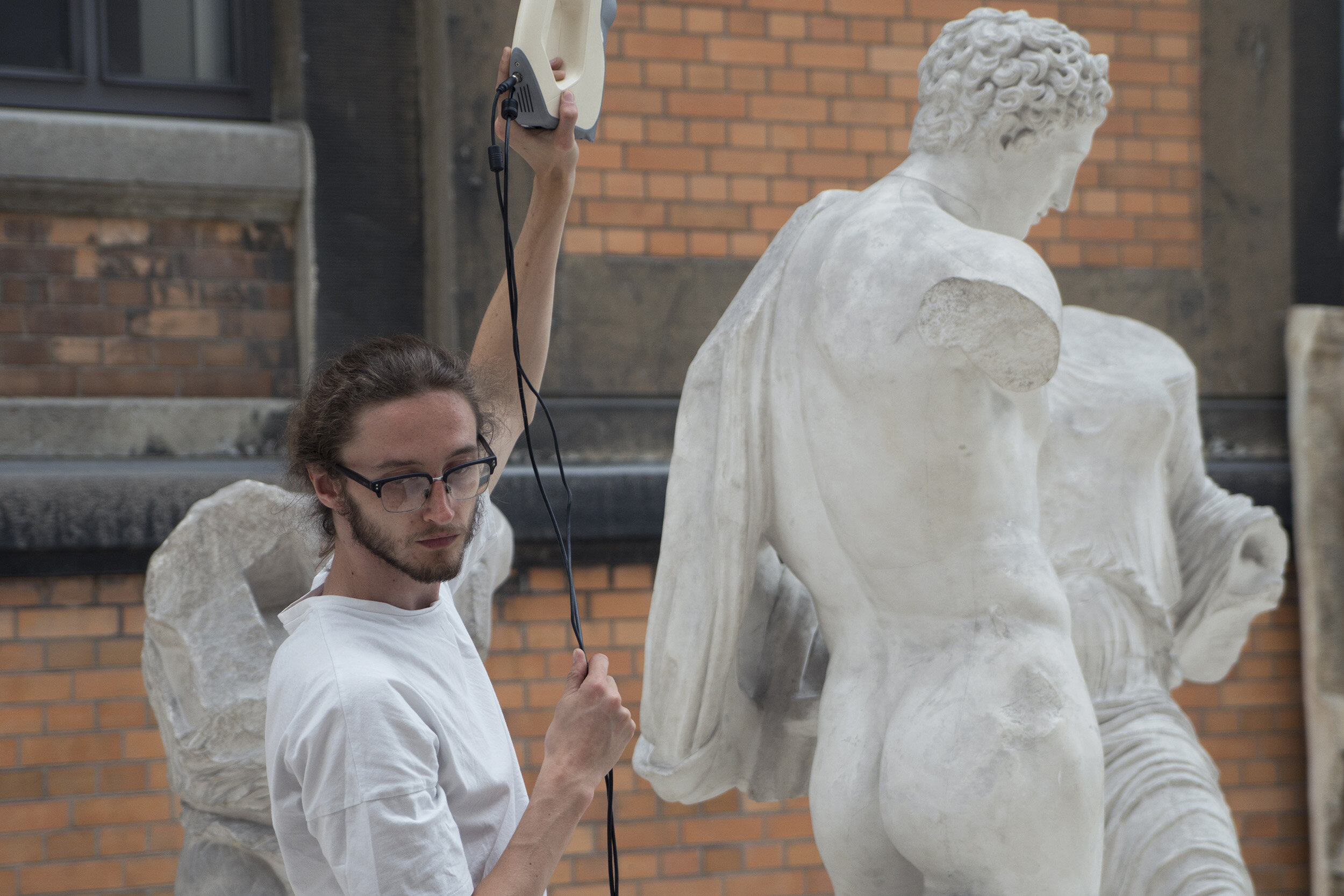Scan the World

Disruptive Devices, Digital Assets, and Digital Cultural Artifacts
By Jon Beck
Excerpted from Volume 40.4 Disperse
In May 2014, I entered the Victoria and Albert Museum (V&A) in London armed with my smartphone. A few hours later I left the galleries with over 10,000 photographs. I had just conducted an art heist. To many visitors and guards, I came across as an over-enthusiastic tourist, though in reality these photographs would soon be converted into over two hundred three-dimensional digital copies of artworks from the collection.
Over the course of the next few months I employed open-source photogrammetry software to stitch together these two-dimensional photographs and reproduce each original artwork as a three-dimensional digital model. A physical copy of the original sculpture could then be produced by 3D printing the digital model. I proceeded to print all facsimiles for less than 2p each (3¢ CAD) using the affordable (and open-source) Fused Deposition Modelling (FDM) 3D printing process. These prints were distributed to friends, charities for the visually impaired, schools, and museum staff. Their digital counterparts were released openly online for anyone to download for free, and those who did were encouraged to share their remixes, prints, and creations back with me. This was the start of a project that would help integrate new technologies into cultural institutions and become the first and leading community-focused archive of its kind. The release of these initial scans created a shift in perception among those involved with the project—it changed how we valued the artifacts and created the opportunity to imagine a power shift between communities and museum spaces.
Image 1 | 3D scanning Head of a Giant with an Artec Eva scanner at the Statens Museum for Kunst, Denmark, 2019. Photograph courtesy of Nick Furbo
The internet and its vast digital landscape of data has affected the ways in which we engage with the physical world around us. In a world where we run the risk of letting the internet estrange us from ourselves and our culture, the digitization and archiving of cultural artifacts has introduced the potential to form a revised relationship to our shared sense of global heritage. Given the malleability of digital files, artifacts can now be copied, modified, and shared globally, in turn augmenting the ways in which we understand and ascribe value to the original artifacts.
The opening of data has ushered in an ease of access to digital artifacts that is in stark contrast to, and gives a certain freedom from, the heavily curated and closed archives we see in museums, galleries, and archives. Unfortunately, like many museum collections, around 95 percent of which are tucked away in archives, this digital information is typically locked behind paywalls, and only those with requisite academic credentials are granted access to it. [1]
One major effect of globalization has been the democratization of technology. Increased access to photography, the internet, and printing, as well as the ability to combine media and functions across all three platforms, has given the public the ability to disrupt established institutions. In the heritage and Galleries, Libraries, Archives, and Museums (GLAM) industries, such technologies have been used to disrupt and influence institutions that are often rooted in colonial-era foundations. In the case of my art heist, the technology available in smartphones (now used by over three billion people worldwide) allowed me to subvert museums’ control of cultural artifacts in order to help further our independent creativity and identities.
With a drive to copy more objects, I recruited some friends and returned to the museums, which were still unsuspicious of the waves of hyperactive photographers photographing every object on view. These meetups soon became referred to as “scanathons,” and over the following months enthusiasts, photographers, museum goers, and museum workers joined in the effort of systematically scanning museum collections. As word of the initiative spread, we started to receive data-sets from all across the globe. Interestingly, submissions were not just limited to Western galleries in Europe and North America, but were also sent from smaller and more rural communities in India and China who wanted to share three-dimensional copies of their heritage with the world. Pushing to make sure “cultural artifacts” were not limited to objects in a gallery, we encouraged scans of everything from architecture to everyday objects that hold a personal or societal importance. In my determination to share copies, I wanted the developing archive to become an unprejudiced collection for anyone to contribute to and an open platform to access and appreciate artifacts from anywhere in the world— without the need to visit a museum. This human-built museum without walls offered the opportunity for anyone to strike relationships between objects across different cultures, and enabled people to share digital surrogates of their traditions openly with the world.
In late 2014, the initiative was given its name, Scan the World, and has since developed into the largest non-profit initiative of its kind. The project’s core values lie in the power of the community to build knowledge and in the object itself as a nucleus in its own narrative and a driver in shaping a living archive. Scan the World has become the largest library of its kind. It has assisted in the digitization of collections from over fifty museums across the globe and has influenced museums to reshape the perception of their digitized collections. At the institution where it all started, the V&A, two objects digitized by the Scan the World community have been permanently acquired and are now on public display under the acquisition numbers A.22-2018 and A.23-2018 in the recently reopened Cast Courts.
[…]
Image 2 | Digital visualization of The Chiaramonti Niobid produced from 3D scan at made at the Statens Museum for Kunst, Denmark, 2019. Image courtesy of Scan the World
Image 3 | 3D scanning at the Statens Museum for Kunst, Denmark, 2019. Photograph courtesy of Scan the World
A Path to Decentralization
The traditional approaches many museums take to their digital collections have, in recent times, raised concerns about ownership, repatriation, sharing, and identity. Digital collections and image licenses are managed and owned by what a museum deems to be the appropriate strategy for monetisation, such as granting permissions for the reproduction of digital images. This leads many to demand extortionate costs and generate unfair limitations on reusing the archive.
In an attempt to refresh the way that these institutions think about their digital collections while remaining economically sustainable, Scan the World is breaking from these traditional attitudes by creating a decentralized ecosystem that encourages and empowers a community to build and give context to the content. In developing Scan the World, I believe that every object tells a story and that an object on Scan the World shouldn’t be bound to one owner or one narrative. Every object in the collection comes from an “original” artifact, linked to an artist, a museum, a collection, etc., but each one is also made by a photographer, a 3D designer, the 3D printer, a curator, remixer, researchers, and so on. All of these people are integral to the object’s creation. With this mindset, Scan the World pushes for digital archives shaped through by the power and ownership they can bring to the people connected to the object, whether their connection is through their heritage or their contribution to the object’s production or digitization. By ensuring every object in the archive is accompanied with the appropriate metadata and accreditation, this community and history is embedded as part of the digital artifact, allowing for a renewed sense of shared knowledge, heritage, and creativity.
We are still a long way from having national museums open their digital archives, especially in the case of larger bureaucracies that have pre-existing revenue models assigned to their collections. This isn’t to say that every gallery or archive should digitize and release their collections, but they should be aware of how devices and communities can be harnessed to embrace the opportunities that digitization can enable in order to make informed, critical decisions about the digital management of their collections.
With its core values of openness, transparency, and sustainability, Scan the World has constructed an active and curated platform, home to over 16,000 3D printable artifacts. As word of these 3D technologies starts to settle in the GLAM sector, museums, we hope, will be able to consider the benefits of opening their digitised collections to the world from a new perspective. With 3D printed versions of artworks sitting proudly in people’s houses, museums are already finding their collections unlocked through the power of Scan the World’s community. Looking into the future, heritage should not be reserved for and interpreted by the lucky few. Instead we should look to embrace digital and physical reproductions of collections to bring the narrative to the masses, encouraging knowledge to be disseminated by people.
Image 4 | Digital visualization of Niklas Byström’s Juno with the Infant Hercules produced from a 3D scan of the artwork at the Nationalmuseum, Sweden, 2019. Image courtesy of Scan the World
Image 5 | 3D scanning at the Nationalmuseum, Sweden, 2019. Photograph courtesy of Scan the World
Notes
1. “Museum image fees—a call to arms,” Art History News, ed. Brendor Grosvenor, September 26, 2017, accessed October 15, 2019, https://www.arthistorynews.com/articles/4810_Museum_image_fees__a_call_ to_arms.
The full version of this article appeared in -SITE 40.4: Disperse.
Bio
Jon Beck is a creative professional exploring the sociological impact of new technologies within the arts and heritage industries. He is an innovator and consultant for digital sectors in museums, implementing new and immersive digital technologies into cultural institutions and studying their use and purposes for global outreach and engagement. Jon founded Scan the World in 2014.










